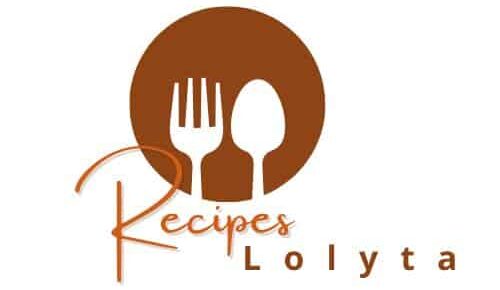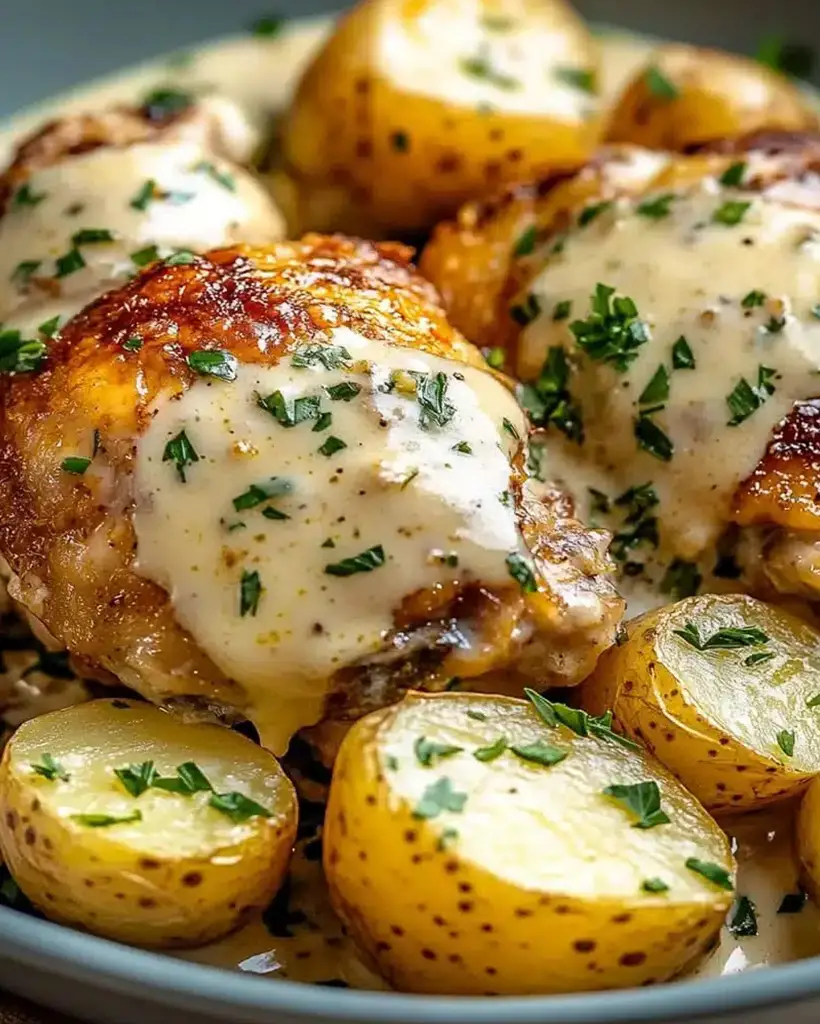Garlic Parmesan Chicken and Potatoes: A Savory Dinner Delight
Imagine a dinner where the aroma of freshly roasted garlic and melted Parmesan fills the room, creating an inviting atmosphere for your family to share. This Garlic Parmesan Chicken and Potatoes recipe brings a symphony of rich flavors and comforting textures to your dinner table. The hint of herbal notes from the rosemary perfectly complements the savory undertones of browned chicken, providing an irresistible feast for all your senses.
The marriage of tender, juicy chicken with golden crispy potatoes highlights the balance between simplicity and sophistication in cooking. As each bite marries the bold and zesty garlic flavor with the creamy nuttiness of Parmesan, you are taken on a culinary journey that is both familiar and novel. The rich aroma and textural contrasts ensure this dish stands out in any dining occasion, from weeknight dinners to special gatherings.
Quick Recipe Highlights
- Flavor Profile: This dish blends the bold taste of garlic and Parmesan with a hint of rosemary, creating a robust yet balanced flavor.
- Texture: The chicken is juicy and succulent, while the potatoes are crispy on the outside and tender within, offering a delightful contrast.
- Aroma: The inviting scent of roasted garlic and melted Parmesan will fill your kitchen, creating an atmosphere that invites gathering.
- Visual Appeal: A rustic yet elegant presentation with golden chicken and crispy potatoes, garnished with fresh herbs.
- Skill Level Needed: The recipe requires basic cooking skills such as roasting and seasoning, making it suited for enthusiastic home cooks.
- Special Equipment: You’ll need a roasting pan or a large skillet to ensure even cooking and a crispy texture.
Recipe Overview
- Difficulty Level: Considered moderate due to the timing required for roasting and ensuring even cooking of both chicken and potatoes.
- Category: This is a hearty main dish perfect for dinner, combining protein and starch for a balanced meal.
- Cuisine: Inspired by classic Italian flavors, integrating elements like garlic and Parmesan synonymous with Italian dining.
- Cost: Moderate, with expenses mainly for chicken, fresh herbs, and quality Parmesan cheese.
- Season: Ideal for cooler weather or any time you crave comfort food, though it’s delicious year-round.
- Occasion: Perfect for family dinners, casual gatherings, and holiday meals where hearty, flavorful dishes are appreciated.
Why You’ll Love This Recipe
The Garlic Parmesan Chicken and Potatoes dish delivers a delightful harmony of taste and texture that is sure to satisfy your palate. The contrasting sensations of juicy chicken and crispy potatoes create a culinary experience that’s both comforting and exciting. Each bite is imbued with the deep and savory flavors of garlic and Parmesan, enhanced by a hint of rosemary that adds a fragrant lift to every mouthful.
Convenience is key with this recipe, as its preparation involves simple steps that fit perfectly into busy lifestyles. With only a modest amount of preparation time required for chopping and seasoning, you can effortlessly bring this delicious meal together, making it an ideal choice for weeknights or quick planning. Moreover, with an oven doing most of the work, you have ample time to relax as your kitchen fills with incredible aromas.
From a nutritional perspective, this dish is balanced with proteins from the chicken and carbohydrates from the potatoes, along with essential vitamins and minerals from the herbs and garlic. The combination encourages a wholesome, nutritious meal without any compromise on flavor. Additionally, it offers a modest caloric intake suitable for those conscious of their dietary goals, all while enjoying a filling and satisfying dish.
Sharing food is one of the greatest joys of life, and this dish is perfectly designed for that. Whether you’re hosting a small gathering or enjoying a cozy family dinner, this recipe is a surefire way to impress and satisfy. Its rich taste and elegant presentation offer an inviting atmosphere, alongside creating memorable meal-time experiences that bring people together.
Finally, Garlic Parmesan Chicken and Potatoes isn’t just about its taste and elegance; it’s also notably cost-effective and accessible. While the ingredients list features quality components like fresh herbs and real Parmesan, they are commonly available and reasonably priced. This allows you to craft a gourmet dish on a dime, proving that fantastic flavor doesn’t necessarily come with a hefty price tag.
Historical Background and Cultural Significance
Garlic and Parmesan have long-standing ties to culinary traditions across Europe, especially within Italian and French cuisine. Garlic, heralded for its bold flavor, has been a staple ingredient since ancient times, used for both its medicinal properties and robust taste. Parmesan, or Parmigiano-Reggiano as it’s traditionally known, roots back to the Middle Ages, a time when it was valued as a luxurious cheese with a rich profile and an extended shelf life.
The cultural importance of this dish extends beyond just its ingredients; it embodies the essence of communal dining. In many cultures, meals featuring roasted meats and vegetables are central to family gatherings and celebrations. The recipe emphasizes sharing and bonding, bringing flavors that are synonymous with comfort and warmth to the table.
As with many classic recipes, the Garlic Parmesan Chicken and Potatoes dish has evolved through generations. Initially crafted as a simple home-cooked meal, it has undergone refinements and variations, adapting to current tastes and dietary needs. Today, it embodies the culinary advancement and fusion of traditional and modern interpretations, making it both timeless and contemporary.
Regional variations of this recipe can be found around the globe, each adding a unique twist. In Sicily, for instance, you might find lemon zest added for brightness, while in France, they’ll include crème fraîche for additional creaminess. This adaptability across various culinary palettes underscores its universal charm and enduring appeal.
Ingredient Deep Dive
Chicken is the foundation of this dish and boasts a rich history of cultural significance. Often heralded as a staple protein, chicken provides versatility and affordability to countless cuisines. Its neutral flavor acts as a perfect canvas for the bold garlic and Parmesan sauce, allowing the herbs and seasonings to shine. Select organic or free-range options for a quality taste and health benefits, which include lean protein and essential nutrients.
Garlic, the recipe’s star flavoring agent, is celebrated not only for its aromatic intensity but also for its health benefits. Known for its anti-inflammatory and immune-boosting properties, garlic enhances this dish with its pungency and depth. When selecting garlic, look for firm, plump bulbs free of molding. Store in a cool, dry location away from sunlight to maintain its freshness.
Potatoes bring substance and heartiness to the dish, providing a robust starch component. Their origin traces back to South America, where they were first domesticated over 7,000 years ago. Nutritious and filling, potatoes are high in vitamin C, potassium, and fiber, making it an essential side that complements the chicken. Choose firm potatoes without green spots, and store them in a dark cool place to prevent sprouting.
Common Mistakes to Avoid
- Overcooking the chicken, leading to a dry texture. Use a meat thermometer to ensure correct doneness.
- Undercooking potatoes can result in a hard texture. Ensure they are cut into uniform pieces for even cooking.
- Not seasoning adequately will result in blandness. Be generous with salt and herbs to enhance flavors.
- Skipping preheating the oven compromises texture and cooking time.
- Using low-quality Parmesan affects the dish’s richness. Opt for aged Parmigiano-Reggiano for true flavor.
- Introducing too much oil can leave the dish greasy. Use just enough to coat ingredients evenly.
- Not resting cooked meat before serving can lead to dry cuts. Allow few minutes rest for juices to redistribute.
- Failing to clean and dry potatoes affects crispiness. Wash thoroughly and pat dry before roasting.
- Low oven temperature prevents proper roasting, resulting in soggy texture.
- Ignoring pan size and crowding leads to uneven cooking; use spacious cookware for best results.
Essential Techniques
Roasting is the core technique in this recipe, crucial for achieving both the crispy texture of potatoes and the juiciness of the chicken. Mastery requires an understanding of temperature control and timing to ensure even browning and moistness. Monitor oven temperature closely, and use a timer to prevent overcooking or undercooking.
Sautéing garlic adds depth to the dish’s flavor profile. Proper technique involves cooking garlic over medium heat until golden, releasing flavor without burning. Watch for visual cues, as burnt garlic can turn bitter, undermining the dish’s intended complexity.
Resting the chicken post-cooking is essential for retaining moisture. This simple yet oft-overlooked step permits muscle fibers to relax, allowing juices to be reabsorbed for succulent chicken pieces. Develop a habit of letting meat rest at least five minutes before serving to achieve optimal juiciness.
Properly integrating the Parmesan requires attention to prevent clumping. Introduce cheese off-heat, ensuring even distribution that coats chicken and potatoes uniformly. This step is key in creating a creamy, cohesive sauce that enhances every bite.
Pro Tips for Perfect Garlic Parmesan Chicken and Potatoes
To develop a deep flavor profile, marinate the chicken in a garlic and herb mixture overnight. This step infuses meat with subtle flavor, elevating every bite with pronounced herbaceous notes.
For extra crispy potatoes, par-boil before roasting. This initial cooking softens the interior, ensuring a tender bite through the golden outer crust. Apply this method to deliver ideal crispy-soft contrast.
Always use fresh, high-quality Parmesan to optimize the dish’s flavor and texture. Pre-grated cheeses often contain anti-caking agents that hinder melting and flavor release. Grating fresh ensures flow and velvety coating.
Herbs are your friend when garnishing; fresh parsley or basil add final bursts of freshness and color, tantalizing both palate and eyes. Finishing touches define the dish’s appeal and complexity.
Incorporate a splash of white wine or stock while roasting for added moisture and flavor enhancement. The aroma developed during evaporation enriches the chicken, adding depth to the sauce.
Don’t rush resting time post-cooking. Allow juices to redistribute by resting chicken under loosely tented foil, retaining optimal moisture and flavor intensity.
Variations and Adaptations
Regional variations encourage culinary creativity; consider incorporating lemon zest or juice for a Sicilian twist, adding brightness that counterbalances rich garlic flavor. This refreshing element uplifts and varies traditional taste.
Seasonal adaptations are simple and effective: swap potatoes with root vegetables like sweet potatoes or parsnips in colder months for a sweet and earthy take. Such shifts align with seasonal produce, enhancing freshness and flavor.
Dietary modifications cater to diverse needs; use gluten-free alternatives ensuring all can savor this culinary fusion. Non-dairy cheese can substitute Parmesan, offering lactose-intolerant diners accessibility.
Flavor variations twofold: entice taste buds with adventurous herbs like thyme or oregano, adding layers of complexity. By varying herbs, you navigate the diverse culinary spectrum.
For texture modifications, consider pulsing herbs and garlic into a panko breadcrumb mixture, adhering this crust to chicken for enhanced crunch. A creative adaptation redefines classic texture expectations.
Presentation alternatives include serving this rustic dish family-style, inviting diners to share and savor communally. Conversely, refined plating on individual servings with artistic garnishes modernizes and sophisticates.
Serving and Presentation Guide
Mastering plating techniques elevates meal enjoyment. Employ garnishes strategically, adding fresh herbs or zest that pop against golden chicken, creating visual appeal and layering additional flavor insights.
A limestone or wooden board enhances rustic charm, offering perfect conduits for showcasing hearty family servings. Plate each element strategically, drawing attention to contrasting textures and colors.
Accompaniments should complement but not overwhelm; a simple green salad or steamed vegetables maintains lightness, balancing rich flavors with fresh, crisp contrasts.
For a contemporary twist, plate individually, ensuring flavor elements complement each other symbiotically. Aim for balanced proportions, each serving a microcosm of the dish’s harmony.
Temperature is key; serve immediately post-rest, when its contrast of warm, juicy chicken and crispy, hot potatoes attains sensory peak. Keep in mind, hot plates maintain meal warmth longer.
Portion control enriches dining experience—avoid overcrowding plates, letting main elements shine and ensuring diners savor each bite thoughtfully, appreciating texture and flavor interaction.
Wine and Beverage Pairing
A medium-bodied wine like Chardonnay harmonizes perfectly, complementing the richness of Parmesan while balancing garlic’s boldness with its crisp, fruity notes. Such pairings enhance and prolong taste notes.
Non-alcoholic alternatives successfully parallel wine’s balancing act; consider ginger ale or lemon-infused sparkling water, infusing brightness and contrast. These options appeal to diners seeking refreshing tang.
For caffeine enthusiasts, pair with bold black tea; its rich tannins complement the savoriness, cutting through richness for a rounded taste experience. Consider mint tea for a refreshing counterpart.
Temperature considerations suggest a delicately chilled wine mildly cools hot dish interactions, maintaining a refreshing mouthfeel. Embrace traditional advice of moderating temperatures paired with savory meals.
Serve beverages with appropriate glassware; beyond aesthetics, the right glass encourages wine’s bouquet, rounding out dining ambiance. Use stemware promoting flavor development and visual delight.
Storage and Shelf Life
This dish’s components warrant special attention to shelf life and storage: refrigerate in airtight containers to maintain moisture and integrity, prolonging enjoyment of leftovers for an additional 3 days.
Temperature requirements stem from keeping leftovers below 40°F, slowing bacterial development. However, once reheated, consume promptly to ensure peak flavor and safety.
Glass containers are ideal for storage, preserving taste and avoiding plastic interaction. Invest in quality containers to enhance storage techniques and food quality.
Signs of spoilage include off odors and discoloration; discard immediately to ensure safety. Maintain vigilance for these cues when handling stored leftovers.
Reheating warrants care—tend towards oven or stovetop to retain crisp texture, avoiding microwave’s tendency to produce sogginess. Retaining flavor and texture emphasizes care in handling.
Freezing guidelines allow extended storage, though potatoes may alter upon thawing; portion chicken and sauce separately, freezing potatoes solely if deemed acceptable, considering textural shifts.
Make Ahead Strategies
Prepare key elements in advance to streamline mealtime; marinating chicken overnight infuses flavor without extra day-of effort, while bundling pre-chopped herbs simplifies assembly.
For storage between steps, utilize airtight containers to hold prepped ingredients, ensuring freshness until cooking completion. This practice amplifies flavors pleasantly.
While making ahead preserves convenience, be mindful of quality impacts—chicken should remain moist and flavorful, potatoes must retain texture integrity; adjust method if diminished.
Assembly tips include dividing tasks methodically, focusing on efficient workflow. This strategy and clear organization streamlines cooking, freeing time for enjoyment.
Reheating requires attention; avoid overcooking, reviving instead by gentle oven heating, preserving crafted dish perfection in flavor and texture.
Fresh elements like herbs should be reserved until just before serving, maintaining vibrant color and fragrant aroma, defining the fresh appeal.
Scaling Instructions
Halving recipes for individual servings demands precise scaling, adjusting ingredient ratios proportionally for consistent taste and texture. Precision ensures stability in scaled-down preparation.
Doubling or tripling involves careful timing observation; larger volumes impact cooking duration, requiring added practice in managing these variables effectively for successful execution.
Larger batches necessitate equipment adjustments; consider investing in expanded pans or increased oven space, identifying scaling needs pertinent to meal preparation and appliance specifications.
Timing modifications depend on increased quantities—ensure proper temperature monitoring, avoiding undercooked components by adjusting accordingly to batch size.
Storage considerations arise with larger quantities—plan refrigeration and freezing availability, ensuring correct space and means to accommodate stored prepared dishes.
Nutritional Deep Dive
Macro breakdown reveals a balanced mixture of protein, carbohydrate, and fat sources, promoting lasting satiety while fulfilling nutritional needs suitably. Vitamins and mineral content offer additional benefits.
Micronutrient analysis highlights chicken’s contribution of key nutrients like niacin and selenium, aiding metabolism and cellular protection, vitalizing diners through well-rounded sustenance.
Health benefits surpass basic nutrition: garlic heralds anti-inflammatory properties while rosemary offers antioxidant richness, enriching both health and taste.
Dietary considerations ensure demanded dietary choices align with nutritional goals, maximizing balanced meals resonant with individual health journeys favorably.
Portion analysis ensures moderation, accounting for caloric and macronutrient needs—maintain mindful serving practices to align meal satisfaction with dietary objectives for beneficial results.
Weight management tips include meal pairing strategies favoring vegetables and lean protein, offering nutrient-dense and filling accompaniments. Meal composition chosen wisely mitigates indulgent overstep.
Dietary Adaptations
Gluten-free dining encompasses a clear path—use gluten-free starch alternatives, ensuring dietary needs coalesce harmoniously within recipe framework.
For dairy-free options, employ nutritional yeast as a Parmesan substitute, maintaining umami and nutty flavor profiles minus milk-based ingredients.
Vegan modifications offer further potential, substituting chicken with plant-based proteins like seitan, preserving intended structure while fostering ethical and dietary preference.
Low-carb meal plans deviate from potatoes, utilizing cauliflower or broccoli alternatives to align carbs while retaining hearty appeal.
Keto modifications engage high-fat, low-carb demands via added oils and reduced carb side choices—creatively aligning fatty richness with prescribed dietary approach.
Paleo adherence leans into proteins and whole produce, eschewing refined products or dairy, adhering to lifestyle priorities aligned with nourishing approach.
Low-FODMAP adaptations focus on garlic-infused oils sans bulbs, ensuring enjoyment while respecting digestive sensitivities common with allium intolerance.
Troubleshooting Guide
Texture issues commonly arise from incorrect cooking times; verify internal temperature and adherence to technique for ideal doneness.
For flavor balance, aversion lies in under-seasoning—adjust herbs, garlic, and salt thoughtfully for enriched complexity and satisfaction.
Temperature problems result in uneven roasting; verify oven calibration and method, ensuring accuracy prevents culinary derailment.
Equipment challenges compel innovative solutions, replacing unavailable pans with adequate alternatives maintaining effective cooking spreads.
Ingredient substitutions necessitate careful consideration: opt for equivalent textures and roles in dish for adequate alternation success.
Timing concerns affect overall experience—preparation and cooking coordination ensure synchrony between steps, achieving optimal Concordia.
Recipe Success Stories
Community feedback reveals wide appeal, with many embracing this dish for gatherings and weeknight dinners, eliciting praise for flavor depth and resultant mealtime satisfaction.
Variation successes abound; enthusiasts have added seasonal vegetables and various herb mixes to create personalized expressions, further demonstrating ingredient versatility in culinary pursuits.
Adaptation stories highlight creative innovations across dietary needs, propelling diverse expression without compromising quality or enjoyment.
Reader suggestions have fostered new avenues, inspiring variations like incorporating citrus elements or adding mushrooms for profundity and enhanced textures.
Photography tips from home cooks emphasize natural light and rustic settings to capture the dish’s essence, authenticity, and appetizing textures.
Frequently Asked Questions
Yes, boneless chicken breasts can be used, but keep in mind they may cook faster. Ensure to adjust cooking time and check for doneness to avoid drying them out.
How can I make the dish spicier?
To add heat, consider incorporating crushed red pepper flakes or a dash of paprika to your seasoning mix. Adjust to your preference for spicy levels while maintaining balanced flavor.
What is the best substitute for Parmesan cheese?
A great alternative is Pecorino Romano, which shares a similar salty profile. Nutritional yeast also offers a non-dairy substitute, bringing that savory, cheesy essence without parmesan.
How do I prevent potatoes from sticking to the pan?
Ensure your potatoes are thoroughly dried before roasting and use a generous amount of olive oil to coat them. This helps create a barrier against the roasting pan and prevent sticking.
Can I prepare this recipe in advance?
Absolutely! Simply season and marinate the chicken and pre-chop the potatoes and herbs in advance. Store separately in sealed containers, ensuring readiness when it’s time to cook.
What’s an easy way to add variety to this dish?
Including seasonal vegetables or experimenting with different herbs like thyme or oregano can provide additional layers of flavor. Try adding sautéed mushrooms for an umami boost.
Are there any dairy-free substitutions for parmesan cheese?
Nutritional yeast provides a savory flavor similar to Parmesan, making it a popular choice for dairy-free diets. A small amount gives bold flavor impact suitable for substitution.
How do I know when the chicken is thoroughly cooked?
Use a food thermometer to check the internal temperature of the chicken. It should read 165°F (75°C) at the thickest part without touching the bone to ensure doneness.
Can I add more garlic to this recipe for flavor?
Yes, additional garlic cloves can enhance the dish’s boldness. Roasting garlic tempers its intensity, integrating smoothly into the recipe profile. Adjust according to desired flavor strength.
What kind of potatoes work best for this recipe?
Yukon Gold potatoes are often preferred for their creamy texture and ability to retain shape during roasting. Red potatoes similarly offer excellent roasting characteristics, holding both flavor and form.
Additional Resources
Enhance your culinary skills and exploration through related recipes exploring variations of garlic and chicken pairings. Dabble in experiments showcasing flavorful twists across differing global cuisine contexts.
Technique guides provide invaluable insights into roasting mastery, crucial for optimizing textures and flavor concentration within potato-centric dishes, ensuring consistent results.
Ingredient information enhances ingredient appreciation, empowering informed selections that maximize flavor exposure and unity within the displayed culinary narrative.
Equipment recommendations seamlessly complement dish preparation; quality roasting pans and kitchen staples ensure an efficient, enriched cooking process.
Seasonal variations encourage adhering to freshest market offerings, celebrating biodiversity and rich flavors as cycles inspire fluctuating culinary creativity.
Print
Garlic Parmesan Chicken and Potatoes
Description
A delicious and savory dish where tender chicken breasts are baked with crispy potatoes topped with garlic and parmesan.
Ingredients
For the Crust:
- 4 boneless, skinless chicken breasts
- 2 cups diced potatoes
- 4 cloves garlic, minced
- 1/2 cup grated Parmesan cheese
- 2 tablespoons olive oil
- 1 teaspoon dried oregano
- 1 teaspoon paprika
- Salt and pepper to taste
Instructions
1. Prepare the Crust:
- Preheat your oven to 400°F (200°C).
- In a large bowl, mix together the olive oil, minced garlic, dried oregano, paprika, salt, and pepper.
- Add the chicken breasts and diced potatoes to the bowl and toss until well coated.
- Place the chicken and potatoes in a single layer on a baking sheet and sprinkle the Parmesan cheese over the top.
- Bake in the preheated oven for 30 minutes, or until the chicken is cooked through and the potatoes are golden brown.
- Remove from oven and let rest for a few minutes before serving.
Notes
You can customize the seasonings to taste.




